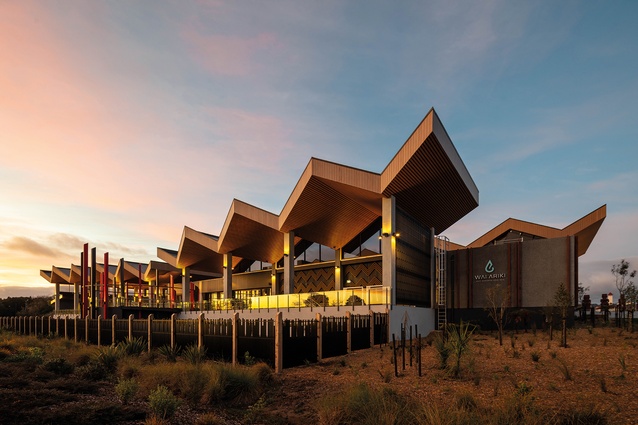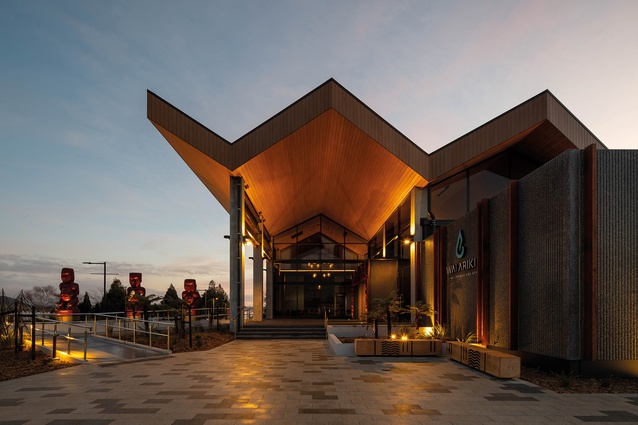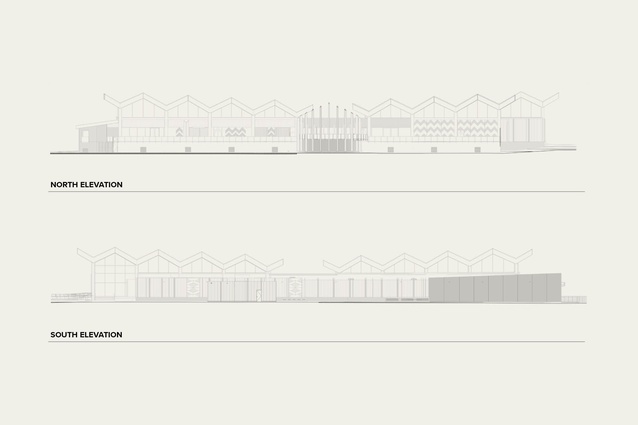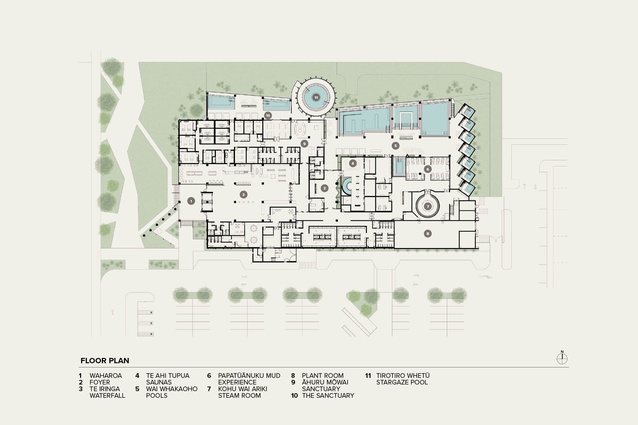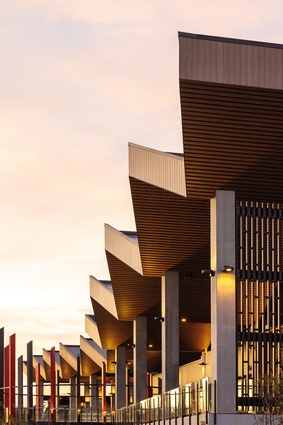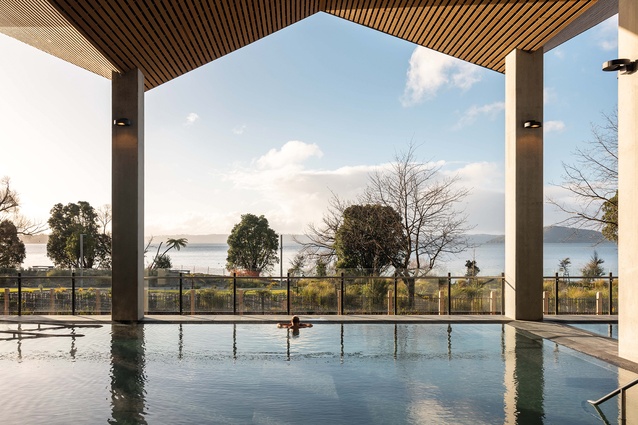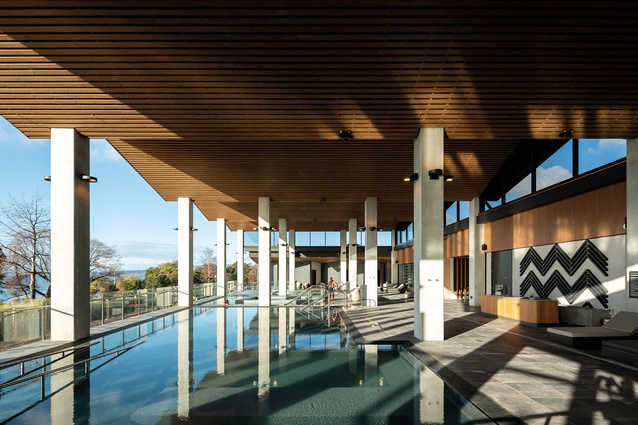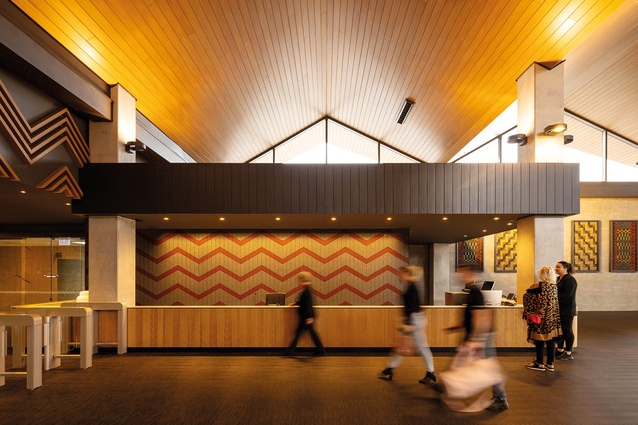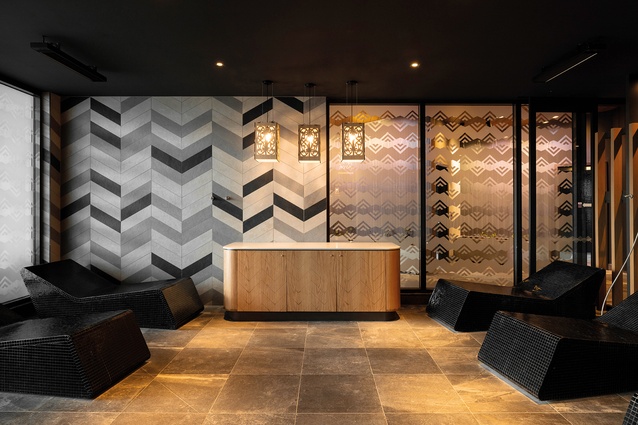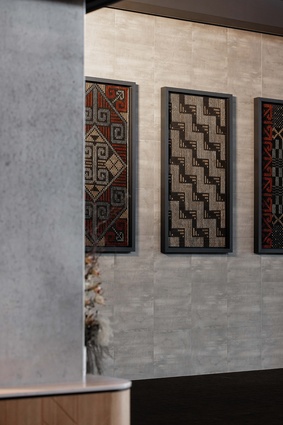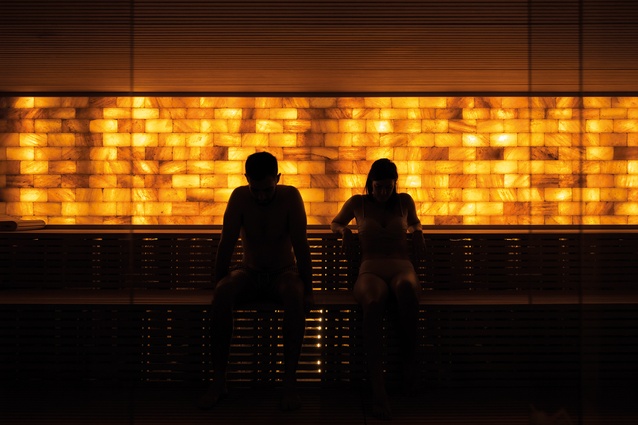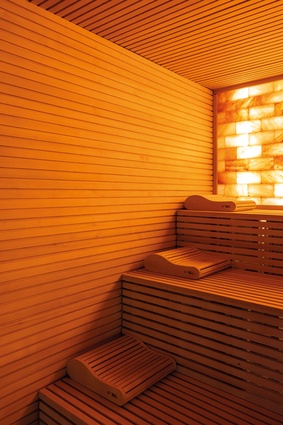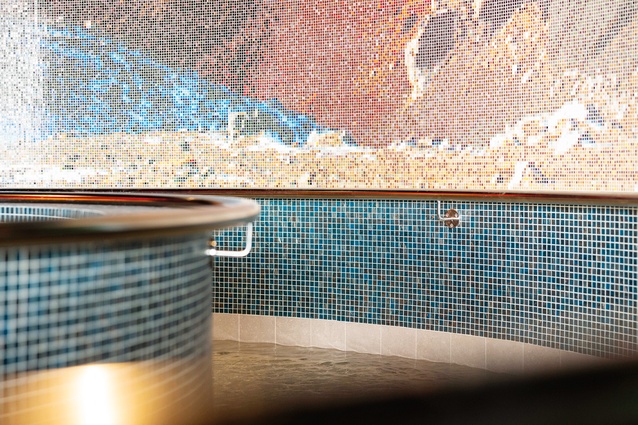Ka hoki ki te whare huri ai e!
Rameka Alexander-Tu’inukuafe (Ngāpuhi, Ngāti Rēhia, Ngāi Tāwake ki te Tuawhenua) and Saul Roberts (Waiohua, Waikato Tainui) take a uniquely Māori view in their exploration of RCG’s Wai Ariki Hot Springs and Spa in Rotorua.
Taking an acutely unique Māori world view, we pay reverence to the prestige of Wai Ariki, to the whenua upon which it stands and to the iwi of Ngāti Whakaue (nō mua, nō muri, nō nāianei), who helped conceptualise and build, and now occupy, this significant Ngāti Whakaue whare as uri whakaheke.
The reviewers’ pātere can be viewed here.
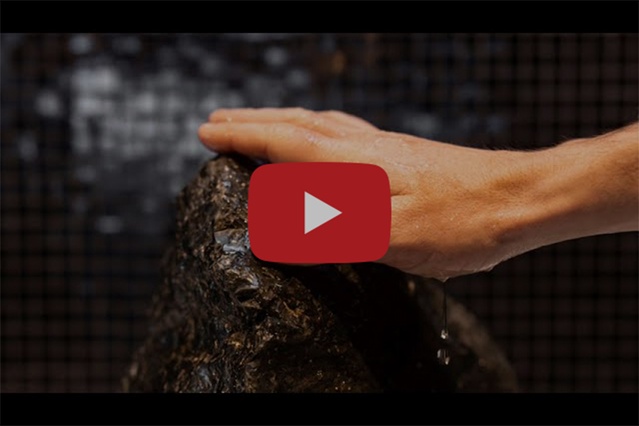
E kō, kōia e tū mai nei! E kō, kōia e ara ake nei!
Ka ū ki Matānuku! Ka ū ki Matārangi! Ka ū ki ngā maunga whakahī o Kupe! Ko Pūhanga Tohorā ka whai ki Te Ramaroa! Ko Te Ramaroa ka heke ki Whiria! Ko te paiaka o te riri, ko te kawa o Rāhiri! Whiria, ka huri ki Panguru ki Papata, te rākau e tū papata ki Te Tai Hauāuru! Panguru, Papata ko Maunga Taniwha Whakarongorua! Maungataniwha ka heke ki Tokerau! Tokerau ko Rākaumangamanga! Rākaumangamanga ko Manaia! Ko Manaia ko Tūtāmoe! Tūtāmoe ko Maunganui!
Ka hārō i te kāhu, ko Te Kāhu Pōkere, ko Te Mānukanuka o Hoturoa! Kei runga, kei te tonga ko Maunga Kiekie e tū noa, ko Maunga Whau te taha whakararo! Ko Te Wai o Huakaiwaka! Nga Wai o Rakataura! Ka rarapa mai ō kanohi ki Te Pūkaki Tapu o Poutūkeka ki Te Puketāpapa ā Hape! Ko Maunga Taketake! Ko Pukeiti! Kei Te Kei o Tainui! Hoki whakamuri mai kei reira a Taramainuku, ko Kaiwhare, rāua ngātahi noho ai! Ka titiro ki Tītīrangi, te taha moana hau raro o te wahapū o Te Mānukanuka o Hoturoa! Ka pupū ki Ōrakei ki te pūwaha o Tāmaki Makaurau ki te whanga i Kawakawa! Ka rere tōtika ki Pirongia ki konei ka whai te tau hiwi ki Ōparau! Ka whiti te moana o Kāwhia ki Te Taharoa! Waikato taniwha rau, he piko, he taniwha!
Ka aroarohaki i o te rae ki Pekerau kai! Te Kureitanga o te ihu o Tama te Kapua! Ka mau te ārohirohi te titiro ki te whenua kura ki Poporohuamea ki Mataoneone! Ka tūtei atu ki te awa kari o Ngātoroirangi: He tai timu, he tai pari e ngaoko ai i te hukahuka! He aha te kai mō roto? He patiki, he tamure, he pāhauariki! He pipi kai oneone, ara rā, ko Papahikahawai! Kia tioro i te tawara o tō waha hei kai e! Rukutia te wai ki ngā taupunga o te waka o Te Arawa! Ko Tūterangiharuru! Ko Te Tokaparore Whakamaua ki te one pungapunga tau atu ai! Urupounamutia mai, he aha te kino i ahau i a Te Arawa! Ka riro rā hei kai atu mā te hatete o Mahuika, Tawhai atu taku rere ki Tapati ki te whare kōrero o Ngāti Whakaue!
E tū whakarehu i te hau hewahewa o Rongomaraeroa e! Nā hea mai koia, te ara ki Whakapoukōrero, ki te puehu muramura i te rua āhuru! Mawhiti atu au ki Te Waiariki koropupū ana i te Rau-o-te-Huia ki Otairoa āku kura tapuwae!
E kō, kōia e tū mai nei! E kō, kōia e ara ake nei!
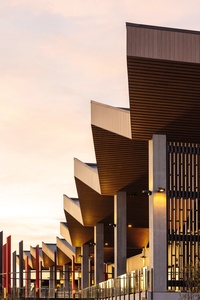
Pukeroa Oruawhata Trust and RCG, the architects for the Wai Ariki Hots Springs and Spa facility, share a long association. Since its establishment in 1980, the trust has grown its asset base to total approximately $376.4m in 2023, providing commercial and charitable opportunities for Ngāti Whakaue descendants and, ultimately, the return of ancestral whenua.
RCG was first awarded the commission by client Pukeroa Lakefront Holdings (a tourism entity of Pukeroa Oruawhata Trust) in 2012. The brief called for a spa and wellness experience that was uniquely Ngāti Whakaue and grounded in Ngāti Whakaue healing practices, to be managed by Belgravia Leisure. There are few facilities of this scale that are developed and owned by indigenous people; therefore, this project has global significance.
The project began with a master plan for the full seven-hectare site, with the briefing, design and documentation stages completed by April 2021 when construction started. Wai Ariki was formally opened in June 2023.
The 4300m2 Wai Ariki facility is situated on a 1.6-hectare site at the eastern end of the redeveloped Rotorua lakefront and positioned to enable a viewshaft along the western boundary to celebrate Te Rotorua-nuia-Kahumatamomoe and the sacred Mokoia beyond.
Wai Ariki sits prominently on the lakefront, a waka that has landed after a long journey. The architecture emerges from the whenua, giving an elevated view of the lake. Internal and functional areas are contained within a rectangular concrete form adorned with patterning and vertical elements. The complex structure floats above a highly active geothermal bed, with the ground-floor level lifted to enable the services and infrastructure to be accessible.
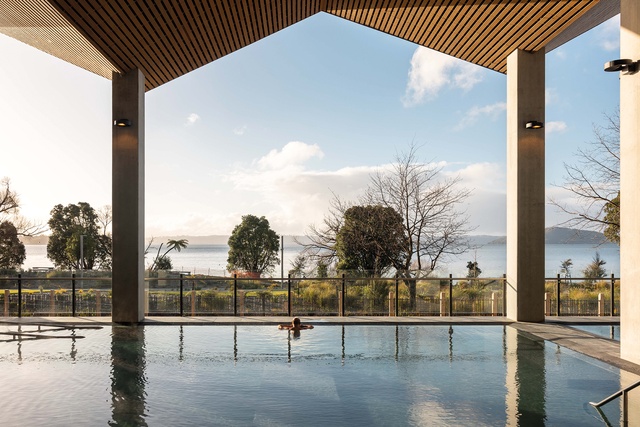
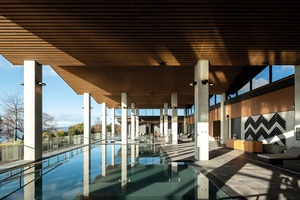
Above the grounded form float three niho taniwha tuanui, creating a triangular horizontal roof line that faces north–south and reaches skyward in the west–east. These tuanui read as the tauihu of Te Arawa waka, a whare gable and tectonic plates giving shelter to the spaces below. The southern tuanui form floats above the entry foyer, with the two northern tuanui sitting above the external pool areas and connected by Te Tirotiro Whetū star-gazing pool, which is open to the sky. The tuanui is held up by solid concrete columns, visible from outside in the open pool area, providing a sense of strength like large rākau found in Te Wao nui-a-Tāne Māhuta.
Together with architects John Lenihan and Alex Liang, we approach Wai Ariki from the tahuaroa in the south. At the entrance to the whare, we are met by six pou whenua representing significant Ngāti Whakaue tūpuna: Te Roro-o-te-Rangi, Tūnohopū, Taeotu, Te Rangi-i-waho, Pūkākī and Hurunga-Te-Rangi. The whakairo were created by pouako and tauira from Te Puia’s New Zealand Māori Arts and Crafts Institute, located in Rotorua. The mahi toi process was facilitated by the client, with the architects working closely with ringa toi to embed these elements into the fabric and overall spa experience journey of Wai Ariki.
At the waharoa below the tuanui, there is an impressive carved pare and whakawae on either side of the doorway. As described by one of the Wai Ariki guides, these whakairo express the pūrākau of the coming of geothermal energy to Aotearoa.
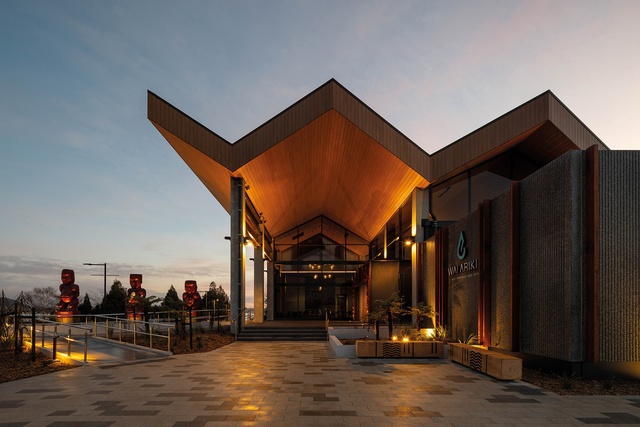
Ngātoroirangi, a powerful tohunga, arrived at Aotearoa on Te Arawa waka, captained by Tamatekapua. After an immense ocean voyage from Hawaiki across Te Moana-nui-a-Kiwa, Te Arawa made landfall at Maketū in the Bay of Plenty.
Ngātoroirangi soon set out to explore and to taunaha whenua. After an epic journey inland, he ended up at present-day maunga Tongariro and, upon reaching the summit, he was caught in an icy storm. Fearing for his life, he called to his sisters Kuiwai and Haungaroa in Hawaiki to help him. They sent Te Pūpū and Te Hoata, subterranean goddesses of fire, to save their brother. With this heat came geothermal activity to Te Waiariki, where geothermal wai and activity is a significant aspect of the landscape. This pūrākau also informs the name for the whare, Wai Ariki, chiefly waters.
As we move from outside into te poho o te whare, we arrive at the foyer, a light and generous space focused around the manaaki of visitors, the hosting of pōwhiri and whakatau ceremonies, with the café, retail and reception/ticketing area located here.
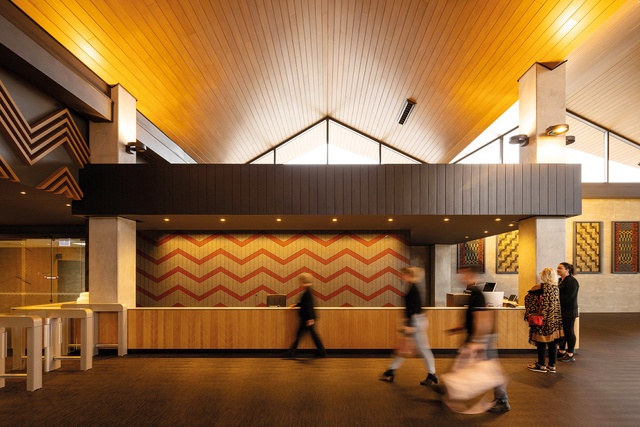
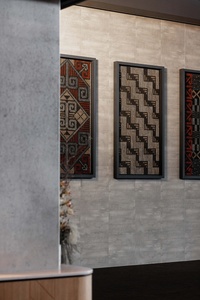
The niho taniwha tuanui and ceiling are clad in timber; the ceiling sits above concrete columns. Walls are adorned with softer materials and tiles, offering further opportunity to visualise the identity of Ngāti Whakaue and Te Arawa. Five turapa woven tukutuku panels, created by Ngāti Whakaue kai raranga, adorn the back wall of the foyer. The overall interior material palette for Wai Ariki is rich in context and refers to the volcanic and geothermal landscape with stone, including scoria, obsidian and basalt, dressing the many surfaces. Wai Ariki embodies the principle of manaakitanga, practised over hundreds of years by Ngāti Whakaue and Te Arawa in the hosting of manuhiri to the many taonga of this unique geothermal landscape.
The architects point to many sustainable design features, describing Wai Ariki as a living biophilic place. Natural geothermal water is used in the pools to heat the underfloor and indoor air as well as to heat the domestic water supply. The concrete floor is also used as a giant heat sink to temper the water before it enters the pools.
In passing the reception, we pause at a significant toka wai feature: a moment to karakia before we undertake our spa journey. It is a point of departure for the two spa experiences: Te Wai Whakaora, referencing Ngātoroirangi’s journey to Tongariro, and the exclusive Te Āhuru Mōwai. The spa journeys unfold in a nonlinear spatial manner, much like the takarangi pattern found in whakairo, where a double spiral intersects and meets at a central point. Manuhiri are taken on an immersive and multi-sensory restorative journey through the key indoor spaces and experiences: Te Iringa cooling waterfall, Te Ahi Tupua saunas, Te Papatūānuku thermal mud experience and Te Kohu Wai Ariki steam room. The main Te Wai Whakaoho pool area for geothermal bathing and an ice-cold plunge experience are covered by the floating tuanui and include private spa pools in the east, offering views to the lake.
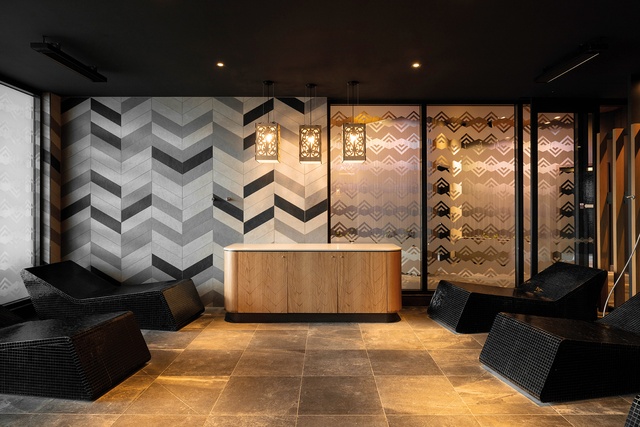
The spa experience is infused with the scents and aromas of local ngāhere and whenua, and includes rongoā and other well-being treatments. Waiata can be heard, and mahi toi and design, and local stone are embedded in the finishing of the interior and exterior spaces. Te Āhuru Mōwai is a more private experience, including unique treatments, a lounge for relaxation and an outdoor pool area. The key intersection of the two spiralling spa experiences is Te Tirotiro Whetū Stargaze Pool, which is open to the sky and surrounded by pou that act as a storytelling and navigational device to key points within the landscape.
Koia nei te wero mā tātou katoa te hunga tātai tātaki whakahoahoa, he tūhono, he takahi i a tātou kaupapa nunui ki ngā kitenga hou, ki ngā kitenga hei haere anga whakamua i a tātou mahi Māori ataahua nei. Ko te whakaaturanga nui kia kitea mai ā māua nei tuhituhi, te āhua o te whakatakoto kōrero, te tūmomo matakite e riro ai mā te tūmomo reo wetewete hei whakatupu, whakatinana i tēnei kaupapa o tēnei whare a Te Wai Ariki e whakaritea nei e nga kaiwhakahoahoa Māori, tauiwi hoki. He kāinga kōrero nui te ao mātauranga tawhito, te ao mātauranga hou, he puna hohouhanga a Rua, hou o te whakaaro. Ko te hinengaro kakama kei te kite, kei te whakakākahu i tēnei kaupapa kia ora ai ngā tūmomo mātauranga, whāngai i ngā kokonga o te hinengaro o ō tātou hāpori kaiwhakahoahoha Māori, tauira whakahoahoa rangahau hoki. Ka tika tonu kia tupu mai ai tēnei pātaka kōrero. Nō reira, me pēwhea ra te whakatupu, te tūāpapa kia koke haere anga whakamua ai?
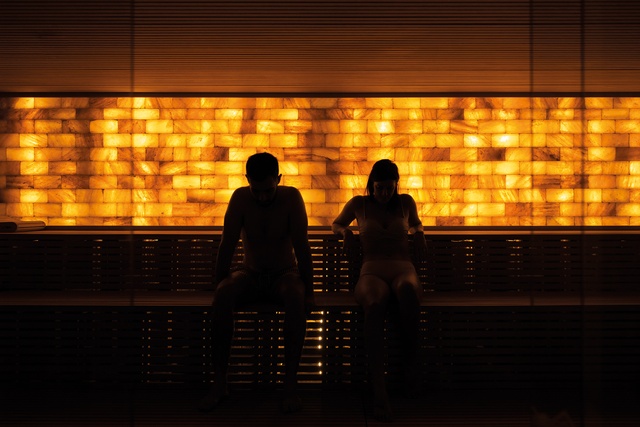
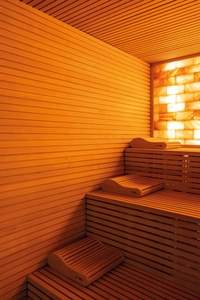
Wai Ariki has given us the opportunity to traverse, to connect and to seek new understandings of kaupapa Māori from this iwi-led project. We have offered insights from this discussion for our architectural community, Māori and tauiwi to consider in future projects and conversations with iwi Māori.
Wai Ariki sits on the landscape as a resilient toka, that references past, present and future aspirations of Ngāti Whakaue, Te Arawa. It is an exciting symbol of Māori architecture and of indigenous excellence. The onus is on all of us, and our architectural community, to deepen our understanding of te ao Māori, te reo Māori me ōna tikanga, but for what purpose? It is that we may reflect and consider the ancient knowledge of iwi Māori, such as Ngāti Whakaue; within that consideration lies an unending potential to develop and bring to the world our unique fabric of Māori knowledge and Māori architecture.
Nō reira ka tika ka huri ki ngā kōrero nō neherā nō te aitanga a Tamatekapua hei whakaeke, hei whakanuia tēnei kaukau i roto i te tumanako:
I au ai kia whakatairangatia te kauae o taku tupuna!
Tamatekapua e tū nei!
Titiro ki ana uri e tau nei!
Ko mātou aha ha ha!
Ko Uenuku aha ha ha!
Te korapanga o te wā o Pūkaki!
I waiho ki a Te Taupua!
Ana hī! Ana ha!
Reference:
1. Saul Roberts’ dissertation research, undergraduate PhD AUT 2023.


